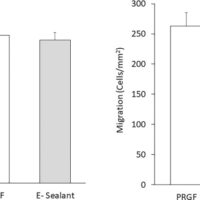- Autor:
- Eduardo Anitua
- Mohammad H. Alkhraisat
- Ander Pino
- Muruzabal F
- Prado R
- Tierno R
- Persinal-Medina M
- Merayo-Lloves J
Biological and Adhesive Properties of an Autologous Protein-Based Fibrin Sealant for Ophthalmological Applications
Abstract
Purpose: The aim of this study was to evaluate the biological and adhesive properties of a new autologous sealant based on plasma rich in growth factors (PRGF), named E-Sealant.
Methods: Conventional PRGF and a commercial fibrin sealant (Tisseel) were included as controls. The hematological and protein content of E-Sealant was determined. Its bioactivity and biocompatibility were tested for human keratocytes (HKs). To evaluate its adhesion and regenerative capacity, E-Sealant was used on an animal model of conjunctival autograft surgery and compared to Tisseel.
.
Results: E-Sealant presented a high growth factor content with levels similar to those of conventional PRGF. E-Sealant induced proliferative and migratory activity on HK cells equivalent to PRGF. Although autologous membranes induced the proliferation of HKs, cells cultured over Tisseel did not adhere nor proliferate. HK cells showed increased number and flattened morphology over PRGF and E-Sealant compared to scarce and round-shape cells detected in Tisseel. Conjunctival autograft glued with E-Sealant adhered successfully, whereas Tisseel application formed irregular clots. During follow-up, both adhesives showed good integration and no dehiscence. However, Tisseel-treated samples presented slightly increased hemorrhage and inflammation. In contrast to Tisseel, E-Sealant-treated autografts presented a continuous layer of non-keratinized stratified squamous epithelium. Inflammatory infiltrates were minimal in E-Sealant-treated conjunctiva, whereas the Tisseel group showed noticeable immune reactions. Unlike Tisseel-treated grafts, E-Sealant presented low immunoreactivity for smooth muscle actin (SMA), suggesting decreased fibrotic tissue formation.
Conclusions: E-Sealant presents optimal biological and adhesive properties suitable for use as an ophthalmic glue, with regenerative purposes superior to commercial fibrin sealants.
Translational relevance: Our study analyzed the characterization and biological activity of a new autologous fibrin sealant in ocular surface cells and in an animal model in which the adhesive and regenerative properties of the fibrin sealant were evaluated.

 English
English
 Français
Français
 Deutsch
Deutsch
 Italiano
Italiano
 Português
Português





